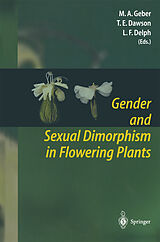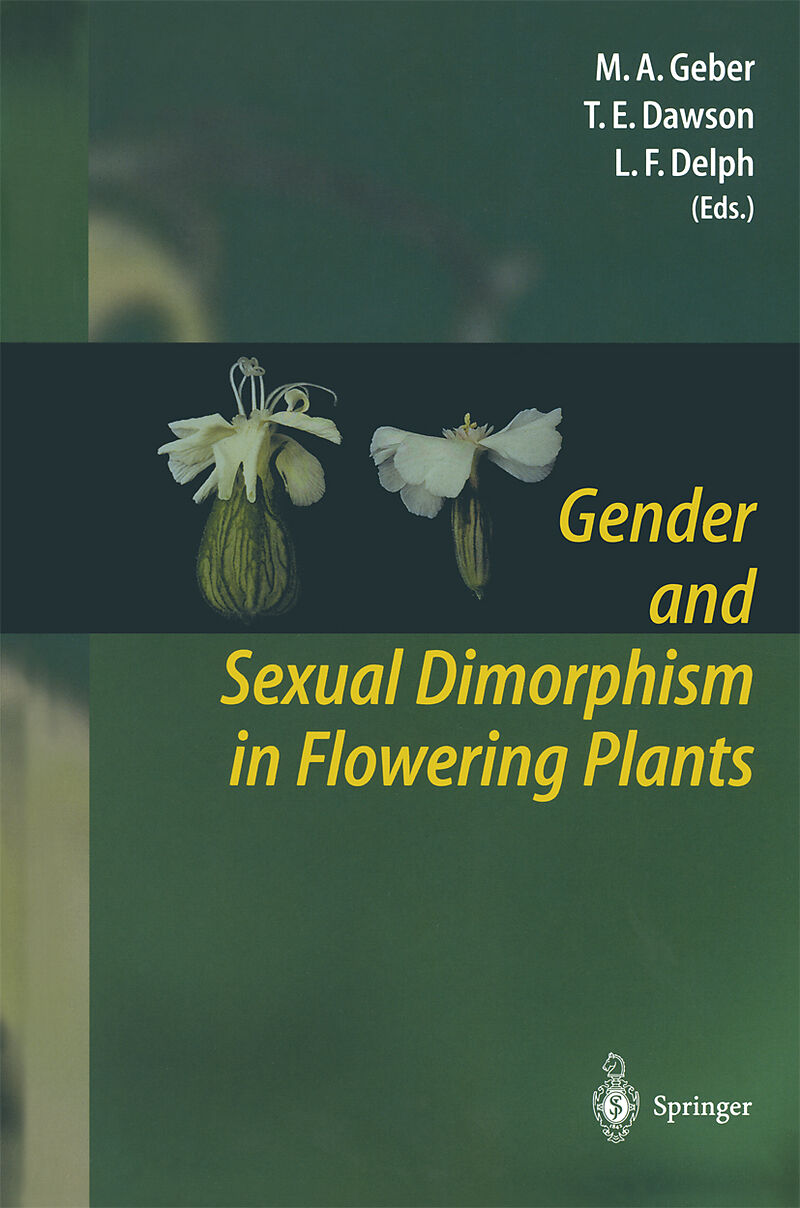Gender and Sexual Dimorphism in Flowering Plants
Einband:
Kartonierter Einband
EAN:
9783642084249
Untertitel:
Englisch
Herausgeber:
Springer Berlin Heidelberg
Auflage:
Softcover reprint of hardcover 1st ed. 1999
Anzahl Seiten:
328
Erscheinungsdatum:
01.12.2010
ISBN:
3642084249
While the majority of flowering plant species are hermaphroditic, gender di morphism, or the occurrence of two sexual morphs, has, nevertheless, evolved on repeated occasions. Gender dimorphism is found in nearly half of all angio sperm families and in approximately 10% of flowering plant species. Where plants are dimorphic in gender, they can also be dimorphic in secondary sex characters. We refer to dimorphism of the latter kind as sexual dimorphism, in keeping with the term's usage by most zoologists. This book is about the evolution of both forms of dimorphism -hence the book's lengthy title. Gender dimorphism in plants has been an active topic of research from theoretical and empirical perspectives, and has been the focus of several re cent reviews and book chapters. By contrast, sexual dimorphism in plants is of the much less widely appreciated. Indeed, the last comprehensive review subject dates back to Lloyd and Webb's 1977 paper on "Secondary Sex Char we first spoke of editing a book on sexual acters in Plants. " In addition, when dimorphism in plants, some people doubted that there was enough material to justify the effort. We hope that this book not only provides an update to Lloyd and Webb's seminal work but also dispels doubts about the widespread nature of sexual dimorphism in plants. We decided to combine reviews of both gender and sexual dimorphism in a single book, because each form of dimorphism can provide the evolutionary impetus for the other.
The first comprehensive review of research on the evolution of gender dimorphism and dimorphism in secondary sex characters in plants Covers both recent advances and historical findings in theoretical and empirical studies Written by the leading experts on plant breeding system evolution
Klappentext
While the majority of flowering plant species are hermaphroditic, gender di morphism, or the occurrence of two sexual morphs, has, nevertheless, evolved on repeated occasions. Gender dimorphism is found in nearly half of all angio sperm families and in approximately 10% of flowering plant species. Where plants are dimorphic in gender, they can also be dimorphic in secondary sex characters. We refer to dimorphism of the latter kind as sexual dimorphism, in keeping with the term's usage by most zoologists. This book is about the evolution of both forms of dimorphism -hence the book's lengthy title. Gender dimorphism in plants has been an active topic of research from theoretical and empirical perspectives, and has been the focus of several re cent reviews and book chapters. By contrast, sexual dimorphism in plants is of the much less widely appreciated. Indeed, the last comprehensive review subject dates back to Lloyd and Webb's 1977 paper on "Secondary Sex Char we first spoke of editing a book on sexual acters in Plants. " In addition, when dimorphism in plants, some people doubted that there was enough material to justify the effort. We hope that this book not only provides an update to Lloyd and Webb's seminal work but also dispels doubts about the widespread nature of sexual dimorphism in plants. We decided to combine reviews of both gender and sexual dimorphism in a single book, because each form of dimorphism can provide the evolutionary impetus for the other.
Inhalt
1 Gender and Sexual Dimorphism in Flowering Plants: A Review of Terminology, Biogeographic patterns, Ecological Correlates, and Phylogenetic Approaches.- 1.1 Introduction.- 1.2 Terminology.- 1.3 Incidence of Dioecy.- 1.4 Importance of Phylogenetic Approaches.- 1.5 Using Phylogenies to Understand Process and Pattern.- 1.6 Conclusions.- References.- 2 Theories of the Evolution of Dioecy.- 2.1 Introduction.- 2.2 Importance of Theoretical Models.- 2.3 Pathways to Dioecy.- 2.4 Theoretical Relationships Between Allocation of Reproductive Resources and Invasion of Populations by New Sex Morphs.- 2.5 Testing the Theory.- 2.6 Conclusions.- 2.7 References.- 3 Empirical Studies: Evolution and Maintenance of Dimorphic Breeding Systems.- 3.1 Introduction.- 3.2 Evolutionary Pathways to Gender Dimorphism.- 3.3 Maintenance of Gender Dimorphism in Natural Populations.- 3.4 Directions for Future Research.- 3.5 Conclusions.- References.- 4 Theories of the Evolution of Sexual Dimorphism.- 4.1 Introduction.- 4.2 Models of Sexual Dimorphism.- 4.3 The Biology of Sexual Dimorphism.- 4.4 Conclusions.- References.- 5 Sexual Dimorphism in Flowers and Inflorescences.- 5.1 Introduction.- 5.2 Patterns.- 5.3 Evolutionary Hypotheses.- 5.4 Conclusions.- References.- 6 Sexual Dimorphism in Live History.- 6.1 Introduction.- 6.2 Predictions Based on Sex-Differential Reproductive Investment.- 6.3 Patterns of Sexual Dimorphism in Life-History Traits.- 6.4 Factors Offsetting Between-Sex Differences in the Cost of Reproduction.- 6.5 The Contrary Case of Silene latifolia.- 6.6 Conclusions.- References.- 7 Dimorphism in Physiology and Morphology.- 7.1 Introduction.- 7.2 History of Studies on Sexual Dimorphism in Plants.- 7.3 Sexual Dimorphism in Plant Form and Function in Species with SSS.- 7.4 Sexual Dimorphism in Plant Form and Function in Species Without SSS.- 7.5 Conclusions and Future Directions.- References.- 8 Sexual Dimorphism and Biotic Interactions.- 8.1 Introduction.- 8.2 Sexual Differences in Competitive Ability.- 8.3 Sexual Differences in Herbivory.- 8.4 Sexual Differences in Parasitism.- 8.5 General Discussion.- References.- 9 Genetics of Gender Dimorphism in Higher Plants.- 9.1 Introduction.- 9.2 Monoecious Plants.- 9.3 Multigenic gender determination systems in dioecious plants.- 9.4 Expression of MADS-box genes in unisexual flowers.- 9.5 Conclusions.- References.- 10 Quantitative Genetics of Sexual Dimorphism.- 10.1 Introduction.- 10.2 Quantitative Genetic Models of Sexual Dimorphism.- 10.3 Integration of Quantitative Genetics with Sexual Selection.- 10.4 Correlated Evolution and Divergence of Male and Female Traits in Dioecious Plants.- 10.5 Correlated Evolution and Divergence of Male and Female Function in Hermaphroditic Plants.- 10.6 Conclusions.- 10.7 References.- Taxonomic Index.

Leider konnten wir für diesen Artikel keine Preise ermitteln ...
billigbuch.ch sucht jetzt für Sie die besten Angebote ...
Die aktuellen Verkaufspreise von 6 Onlineshops werden in Realtime abgefragt.
Sie können das gewünschte Produkt anschliessend direkt beim Anbieter Ihrer Wahl bestellen.
Loading...
Die aktuellen Verkaufspreise von 6 Onlineshops werden in Realtime abgefragt.
Sie können das gewünschte Produkt anschliessend direkt beim Anbieter Ihrer Wahl bestellen.
| # | Onlineshop | Preis CHF | Versand CHF | Total CHF | ||
|---|---|---|---|---|---|---|
| 1 | Seller | 0.00 | 0.00 | 0.00 |
